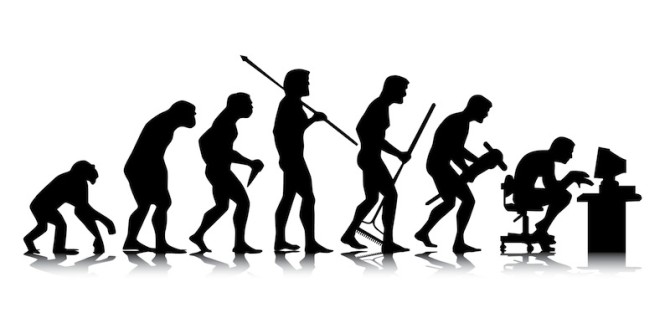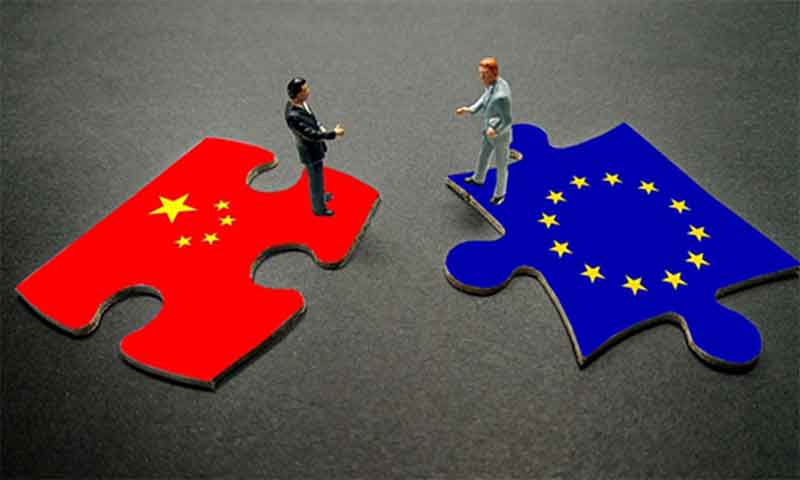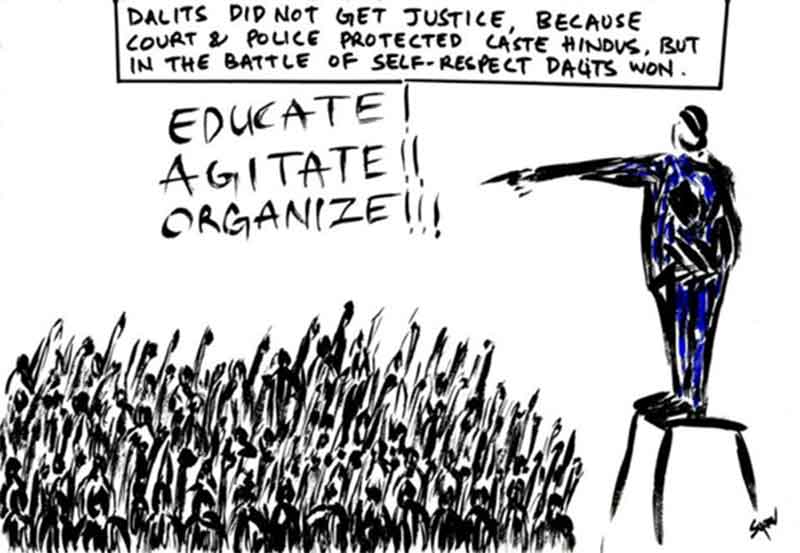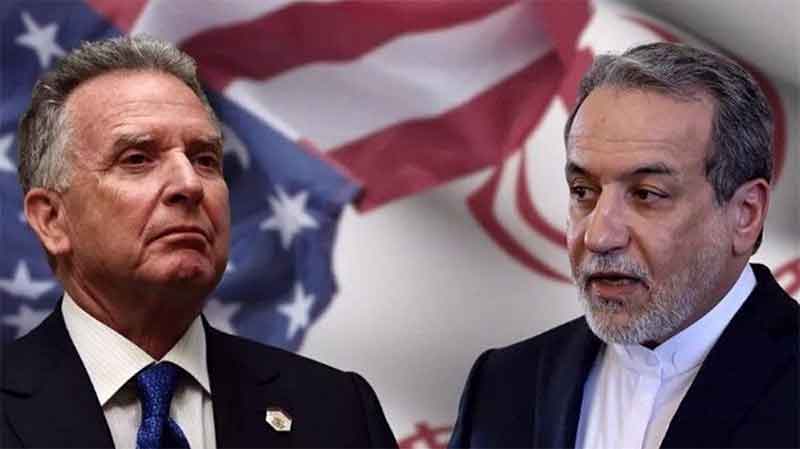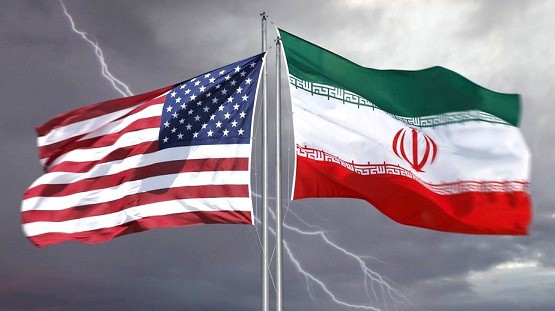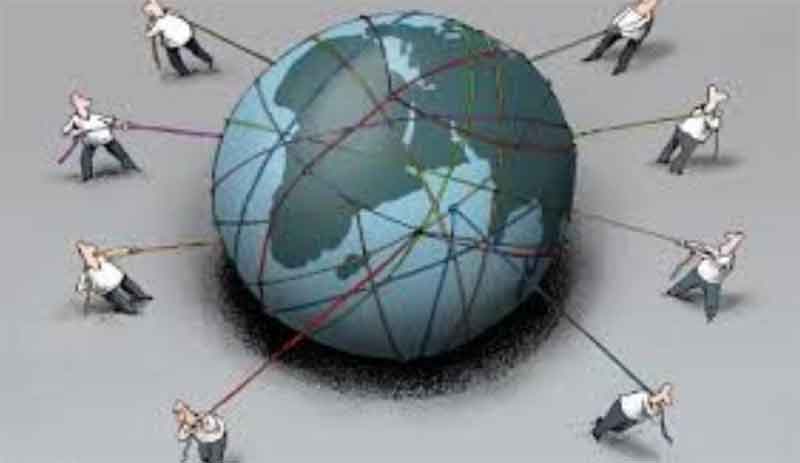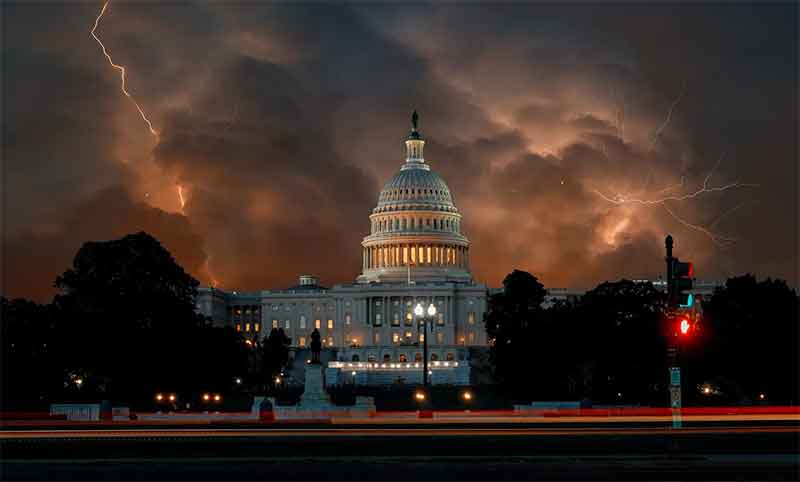
The world has changed dramatically since the start of the second Trump administration. But how best to describe this shift? Many see it as potentially the end of American democracy, or the end of the Atlantic Alliance and the United States’ prime role in global multilateral institutions.
Here’s a less obvious take: maybe Trump’s ascent portends the end of Big Solutions. The latter have been necessitated by the eruption of Big Problems—i.e., global predicaments that are potential civilization killers, including climate change, worsening economic inequality, the spread of persistent toxins throughout the environment, and the accelerating loss of wild nature. Some scholars call the convergence of Big Problems a polycrisis; others say it’s the start of a Great Unraveling. Whatever you want to call it, we face an unprecedented confluence of profound, compounding challenges.
Since many modern nations are larger, wealthier, and far more technologically capable than any previous ones, it stands to reason that they should direct some of their formidable resources toward staving off disaster. They have done this largely through regulations, treaties, and investments. National regulations have protected water and air; international treaties have banned dangerous chemicals and certain classes of weapons and have set aside natural habitat so that threatened species can recover; and government investments and tax breaks have promoted “clean” energy.
A flagship example of Big Solutions is the international community’s main fix for climate change: the energy transition from fossil fuels to renewable energy. It promises a massive economic and industrial transformation and requires heaps of subsidies and regulations, along with annual international meetings and pledges of action.
Big Solutions are not just the province of governments. Big Philanthropy funds action by big non-governmental organizations (NGOs). Meanwhile, Big Solution industries seek to make a profit by doing good works in the commercial sector—such as by manufacturing solar panels and electric cars.
Big Solutions have been around for years, in some cases decades. Yet society’s Big Problems are still getting worse, not better. Now the Trump administration is signaling a pullback from most solution efforts. Climate change, inequality, global health crises, toxics, and biodiversity loss—all are being de-prioritized. Trump’s withdrawal from the Paris Climate Accord is just one of a series of coordinated official policies that downplay, ignore, or unwittingly add to Big Problems (“Drill, baby, drill!”).
Given the leadership role that the US has played in in Big Solutions in recent decades, this policy of withdrawal marks a sea change globally. In nearly every international solutions effort (except the International Criminal Court and conferences to ban land mines), Washington has played a primary role. Even though the US was one of the top per capita carbon emitters, it helped forge the Paris Accord in 2015. Although the US produced a large proportion of the world’s ozone-harming chlorofluorocarbon chemicals, it helped negotiate the Montreal Protocol that banned such chemicals.
So, with the US now pulling back from promoting Big Solutions, who will take up the slack? Most countries are too poor or small to do much. Others, like Russia, India, and China, are charting their own sluggish paths toward a distant energy transition: Russia shows little interest in global problems, China is hoping to profit from them, and India, while having enormous vulnerability to climate change, is primarily just interested in rapidly expanding its middle class. That leaves Europe as the main advocate for Big Solutions; however, it is unlikely that Brussels, London, Berlin, or Paris will be as effective at driving global action as Washington was. Indeed, the European Union has recently softened its stance on phasing out fossil fuel engines and has declared nuclear and gas energy “sustainable” (even though uranium and natural gas are fast depleting, polluting nonrenewable resources). Some solution activists have long argued that US global leadership was ineffective, self-serving, and often counter-productive. But, even so, with America now abandoning its former commitments, it is unclear where Big Solutions could come from.
Big Philanthropy appears to be parallelling the actions of the US government. The Gates Foundation, by far the largest private philanthropic organization on the planet, has recently canceled most of its climate action funding. The reason is somewhat unclear, though the decision appears to have been made following a long in-person meeting between Bill Gates and President Trump. We have seen the capitulation of major law firms, universities, and media companies to threats from the Trump Administration; the move by Gates may be a signal of similar shifts in the world of philanthropy.
The drying up of foundation grants for the promotion of Big Solutions would make it much harder for NGOs to continue their efforts. In this context, it’s especially ominous that the US chapter of Greenpeace (one of the largest environmental organizations in the country) was recently saddled with a 660 million dollar fine after being sued by a fossil-fuel pipeline company. Unless that judgment is reversed on appeal, US Greenpeace will likely have to shut down.
Even big banks are pulling back from clean energy pledges. A report published by Scientific American found that Morgan Stanley, JPMorgan Chase, and the Institute of International Finance are pivoting away from energy transition investments and toward sectors like air conditioning. A Morgan Stanley analyst is quoted as saying, “We now expect a 3 degree world.”
Three Reasons Big Solutions Are Ending
Although the actions of the Trump administration are decisive in bringing about the end of Big Solutions, they are not the only drivers of this disturbing shift. Altogether, there are three:
First, Big Solutions weren’t working. To be sure, there have been a few instances in which Big Problems were bigly defeated: due to the Montreal Protocol, the Earth’s ozone layer is recovering, and DDT has been banned in many countries. But arguably the biggest of our Big Problems, climate change, is still worsening despite three decades of conferences, international agreements, and investments. Global carbon emissions are still increasing, the CO2 content of the atmosphere is still growing, temperature extremes are worsening, and the consequences for society are becoming more apparent (just one example: due to worsening wildfires and storms, US insurance companies are now refusing to write policies or dramatically raising rates for hundreds of thousands of homeowners in areas prone to fires or floods).
Other Big Problems are likewise proving intractable. Economic inequality is increasing across most of the globe, and the rate of decline in the numbers of non-domesticated animals and plants is accelerating. Also, new toxic chemicals are being introduced to the environment faster than we can identify and ban ones that we released years ago, and the overall quantities of toxins being dispersed are growing.
Many experts, when discussing our modern age, emphasize improvements. Hundreds of millions of people have been lifted out of poverty. Average lifespans have lengthened due to better sanitation and medical advances. Education is more freely available than ever before. We can do things that, only decades ago, were the stuff of science fiction. But some of those improvements now appear fleeting. We have created temporary abundance by depleting and degrading the biosphere—burning fossil fuels, overexploiting agricultural land, extracting and dispersing minerals, deforesting, and polluting. We can only do that for so long before consequences begin to undermine any advantages we reap, and humanity starts losing ground.
Experts dispute why Big Solutions haven’t worked. Most seem to assume that, given enough time and additional investment, solutions could still succeed. However, a small minority of observers has persistently claimed that society’s pursuit of further economic growth has effectively defeated Big Solutions by causing Big Problems to grow faster than solutions can be deployed.
Second, the masses were never enlisted. Since Big Solutions have been driven largely by governments, most ordinary people have been content to be mere spectators in the fight against Big Problems. A minority of regular folks buy electric cars or solar panels, or take the time to read the list of ingredients on products so as to avoid toxics. But the majority do none of these things; they fear worsening weather extremes but feel dwarfed by the scale of the climate crisis and therefore do nothing to help keep it at bay.
Nor have they been asked to do much. Their government has never told them that overcoming Big Problems will require that everyone work together, sacrifice, and use their creativity. Instead, the masses have been reassured that technology and bureaucracy (industry and government) would supply Big Solutions.
Above all, the masses were told that solutions would require and enable endless economic growth. Only through growth can governments afford investments in renewable energy and other Big Solutions; only with expanding markets can industries research, engineer, and manufacture alternative, low-carbon technologies or non-toxic products. In fact, however, each new increment of economic growth has made nearly all Big Problems still bigger and harder to solve. Tackling climate change and other Big Problems will require us to transform how we live and what we aim for in life. We must use less energy and less raw material, and we must do less motorized transporting of people and goods. The only way we can ratchet down industrial production, transport, consumerism, and capitalism without causing a revolt of the masses is if most people understand what’s at stake and cooperate, and if the folks in charge inspire good behavior through example. The transition would probably require rationing energy and goods, and taxing rich people and corporations at much higher rates. But those strategies are seldom mentioned by Big Solution proponents in government or industry.
Third, the people in charge have lost interest. Maybe if the political elites were unified and consistent, they’d just keep hammering away at Big Solutions for the foreseeable future. But there has been a pivotal changing of the guard, and with it comes a new attitude toward both Big Problems and Big Solutions. Here’s the Trump Administration’s new Secretary of Energy, Chris Wright, addressing climate change:
“The Trump administration will treat climate change for what it is, a global physical phenomenon that is a side effect of building the modern world. We have indeed raised global atmospheric CO2 concentration by 50% in the process of more than doubling human life expectancy, lifting millions of the world’s . . . citizens out of grinding poverty, launching modern medicine, telecommunications, planes, trains and automobiles too. . . . We are entering truly exciting times for human progress . . . if we can get out of the way and unleash the human spirit.”
Wright’s statement requires translation, as it begs more questions than it answers (the most obvious one: if the admittedly real global physical phenomenon of climate change threatens humanity and much of the biosphere, shouldn’t we be doing something about it?). Wright seems merely to be saying that, however awful climate change may be, it is a reasonable price to pay for all the goodies of the modern world. However, curiously, he does not then say that we should make that price as small as possible by implementing Big Solutions. Instead, he implies that, if solutions exist, they will only reveal themselves if society jets ahead, disregarding all regulations and dashboard warning lights.
This way of looking at things seems congruent with an ideology popular among Elon Musk and his peers—accelerationism, which calls for the drastic intensification of capitalist growth and technological change so as to destabilize society and usher in a new authoritarian, technocratic political-social order. To be fair, in the eyes of its adherents, accelerationism could be considered an alternative Big Solution: it recognizes existential threats to humanity, which it proposes to defeat by colonizing the solar system and decoupling our minds from our bodies through advanced technology. The way forward requires shifting all control and resources toward the elite, who can steer humanity toward that future. The deaths of millions in Africa due to the shutdown of USAID (just one example) is therefore considered a sad but necessary consequence of setting the “right” priorities.
An alternative, simpler, and more straightforward translation of Wright’s statement might be the following:
“We understand that what we are doing will lead to catastrophe. But, in the short run, there’s still money to be made, and we’ll make more of it if we proceed single-mindedly and stop wasting effort on ‘solutions’ that don’t really work. When catastrophe comes, those of us who were smart enough to make heaps of money will be able to insulate ourselves from the impacts more successfully than most other people, so we represent our species’ best hopes for survival and flourishing.”
Big Problems, Small Solutions?
Big Solutions will not entirely go away soon for two reasons. First, some have market momentum. Specifically, electric cars and solar panels will likely continue to proliferate, if perhaps more slowly. While they aren’t stopping climate change, for people who can afford them they make sense from the standpoint of household economics.
The other durable driver of Big Solutions is social momentum. Globally, hundreds of thousands of activists, government bureaucrats, and staffers in environmental orgs share sunken investments of time, education, expertise, and reputation. Their hopes and fears for themselves, their families, and their communities are entwined with Big Solutions. Much of these people’s work is heroic and worthwhile. Even if it has not stopped Big Problems, it has arguably slowed their worsening, and, in many cases, has made a significant difference to local ecosystems and human populations. Many activists’ natural response to Trump policies will be to try to revive Big Solutions. But that could take a while, and by the time Big Solutions are resurrected (if they can be), Big Problems will have exploded in dimension.
Meanwhile, can small solutions work? Many environmentalists have been promoting them all along. There is a rich literature on localization, degrowth, community resilience, and Indigenous attitudes and practices, and small environmental orgs have sprung up to further these strategies. Proponents of small solutions don’t claim that these actions will enable humanity to continue its current growth trajectory while canceling growth’s negative impacts on people and the planet. Rather, Small Is Beautiful promoters say we should preserve and repair as much as we humanly can of nature and durable human culture, and do this individually and in our households and communities, where we have the most agency. Small-scale, localized approaches can also build adaptive capacity and resilience as Big Solutions fail.
Big Solutionists have dismissed this approach, arguing that small solutions can’t scale up to meet global challenges. The counterargument from the proponents of localism and degrowth is that, in the final analysis, small solutions are the only ones that will lead us toward a world that’s healthy and sustainable. Our ends and means must be congruent.
The end of Big Solutions is perhaps the end of an illusion. But it is hardly the end of our opportunities to make a difference.
Richard Heinberg is Senior Fellow of Post Carbon Institute, and is regarded as one of the world’s foremost advocates for a shift away from our current reliance on fossil fuels. He is the author of fourteen books, including some of the seminal works on society’s current energy and environmental sustainability crisis. He has authored hundreds of essays and articles that have appeared in such journals as Nature and The Wall Street Journal; delivered hundreds of lectures on energy and climate issues to audiences on six continents; and has been quoted and interviewed countless times for print, television, and radio. His monthly MuseLetter has been in publication since 1992.
Originally published by Resilience.org


